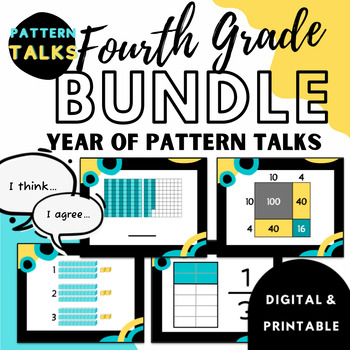Complete Fourth Grade BUNDLE - Pattern Number Talks
- Zip
Products in this Bundle (20)
showing 1-5 of 20 products
Description
Pattern Talks are an easy 10-minute a-day routine to help students master fourth grade math standards. Get your students engaged in their math this year with this enriching, easy-to-use math routine, and watch the conversations blossom!
Card sets in BOTH NO-PREP GOOGLE SLIDES AND PRINTABLE VERSIONS include math visuals, number labels, and fill-in-the-blank equations to promote observation, mathematical discourse, teamwork, and daily math practice in important math concepts.
Each talk is low to no-prep and includes a one-page teacher how-to guide so that you can lead Pattern Talks in your class like a pro, even if it's your first time! Even better, the no-prep digital slides list the steps and questions right on the slide, and the slide animations will guide you through each of the three steps!
These talks are GREAT additions to your morning meeting, calendar time, or math warm-ups. They can be used for both pre-teaching and review!
What is a Pattern Talk?
Pattern Talks are sets of digital or printable cards (this bundle includes both versions) that follow a math pattern and illustrate key math concepts with both visuals and numbers. Each day, the teacher reveals one new card following this simple, three-step process:
- Students predict the next card before it's revealed: Get students thinking about the patterns in the cards, drawing on previous class discussions. This is a great opportunity to practice math concepts since students are generating math visuals independently and then checking. Students share their predictions and explain their reasoning. Then, you reveal the card so students can check.
- Students label with a number or solve the equation (depending on the talk): Cards include visual aids to support students. The how-to guide included with each talk also lists suggestions for hands-on manipulatives that could be used for more scaffolding. Then, students share their thoughts and discuss with classmates. This is a great time to practice respectfully agreeing and disagreeing with others! Then, reveal the answer so students can check.
- Analyze patterns across the cards: Do your students know what the pattern is? This is a time to analyze the cards to notice patterns. Cards include visuals and numbers, so there is usually more than one thing to notice and discuss!
What's Included?
- 10 Pattern Talks card sets illustrating important standards-based math concepts. This set includes cards for 126 days of instruction.
- Access to BOTH DIGITAL (Google Slides) AND PRINTABLE versions of EVERY PATTERN TALK
- How-to-Use guides for every talk including any prep necessary, key questions and learning to highlight, and optional manipulatives to further scaffold students
Why Use Pattern Talks?
More teachers are using Pattern Talks in their classrooms because they are...
- Quick and easy! My students often walk away with more learning after this 10-minute-a-day classroom discussion than from our formal math lesson.
- Are engaging! All students are invited to think, participate with manipulatives, share their thinking, agree/disagree with classmates, and ask each other questions!
- Increase in complexity. Pattern Talks scaffold students as they move from simpler more accessible problems to more challenging ones.
- Make learning accessible. Pattern talks repeat the 3-step process, providing a routine that makes it easier for all students, including ELLs, to engage. Students who were not ready to share their ideas yesterday might try out strategies others have shared, and find success today! Pattern Talks provide enough time for everyone to learn and share their success!
Frequently Asked Questions
Who are Pattern Talks for?
This bundle was created to help busy fourth grade teachers who want to facilitate class talk and get their students engaged in their math learning WITHOUT taking up their precious planning time!
How long does a Pattern Talk take?
Each day requires about 10 minutes of instructional time, so I find it's best to build it into existing routine times like morning meeting, calendar time, or math warm-up. Each talk spans anywhere from 10-20 school days.
Do I need to print out a new card set every day?
NO! These talks are meant for whole-class instruction. Print one card and hang it in a prominent place in the classroom, or use the digital slides which require NO PREP!
Do I need to teach the Pattern Talks in order?
Not at all! Each talk focuses on a different math concept. Use Pattern Talks to align with your school curriculum, or use them as pre-teaching or review materials!




